#paleoproterozoic
Explore tagged Tumblr posts
Text

Earths timeline part 1 (in order top to bottom and colour coded)
Master post (of earths timeline), Part 2
Precambrian
Hadean eon (4.6 - 4.031 billion years ago)
Archaeozoic/Archean eon (4.031 - 2.5 billion years ago)
Eoarchean era (4 - 3.6 billion years ago) Paleoarchean era (3.6 - 3.2 billion years ago) Mesoarchean era (3.2 - 2.8 billion years ago) Neoarchean era (2.8 - 2.5 billion years ago)
Proterozoic eon (2.5 billion - 541 million years ago)
Paleoproterozoic era (2.5 - 1.6 billion years ago) Siderian period (2.5 - 2.3 billion years ago) Rhyacian period (2.3 - 2.05 billion years ago) Orosirian period (2.05 - 1.8 billion years ago) Statherian period (1.8 - 1.6 billion years ago) Mesoproterozoic era (1.6 - 1 billion years ago) Calymmian period (1.6 - 1.4 billion years ago) Ectasian period (1.4 - 1.2 billion years ago) Stenian period (1.2 - 1 billion years ago) Neoproterozoic era (1 billion - 538.8 million years ago) Tonian period (1 billion - 720 million years ago) Cryogenian period (720 - 635 million years ago) Ediacaran period (635 - 538.8 million years ago)
Postcambrian
Phanerozoic Eon (538.8 million years ago - current)
Paleozoic era (538.8 - 252 million years ago) Cambrian period (538.8 - 485.4 million years ago) Terreneuvian epoch (538.8 - 509 million years ago) Fortunian (538.8 - 529 million years ago) Stage 2 (529 - 521 million years ago) Series 2 (521 - 509 million years ago) Stage 3 (521 - 514 million years ago) Stage 4 (514 - 509 million years ago) Miaolingian epoch (509 - 497 million years ago) Wuliuan (509 - 504.5 million years ago) Drumian (504.5 - 500.5 million years ago) Guzhangian (500.5 - 497 million years ago) Furongian epoch (497 - 485.4 million years ago) Paibian (497 - 494 million years ago) Jiangshania (494 - 489.5 million years ago) Stage 10 (489.5 - 485.4 million years ago) Ordovician period (485.4 - 443.8 million years ago) Early Ordovician (485.4 - 470 million years ago) Tremadocian (485.4 - 477.7 million years ago) Floian (477.7 - 470 million years ago) Middle Ordovician (470 458.4 million years ago) Dapingian (470 - 467.3 million years ago) Darriwilian (467.3 - 458.4 million years ago) Upper Ordovician (458.4 - 443.8 million years ago) Sandbian (458.4 - 453 million years ago) Katian (453 - 445.2 million years ago) Hirnantian (445.2 - 443.8 million years ago) Silurian period (443.8 - 419.2 million years ago) Llandovery Epoch (443.8 - 433.4 million years ago) Rhuddanian (443.8 - 440.8 million years ago) Aeronian (440.8 - 438.5 million years ago) Telychian (438.5 - 433.4 million years ago) Ludlow (427.4 - 423 million years ago) Gorstian (427.4 - 425.6 million years ago) Ludfordian (425.6 - 423 million years ago) Pridoli (423 - 419.2 million years ago) Devonian period (419.2 - 358.9 million years ago) Early Devonian (419.2 - 393.3 million years ago) Lochkovian Stage (419.2 - 410.8 million years ago) Pragian (410.8 - 407.6 million years ago) Emsian (407.6 - 393.3 million years ago) Middle Devonian (393.3 - 382.7 million years ago) Eifelian (393.3 - 387.7 million years ago) Givetian (387.7 - 382.7 million years ago) Upper Devonian (382.7 - 358.9 million years ago) Frasnian (382.7 - 372.2 million years ago) Famennian (372.2 - 358.9 million years ago) Carboniferous period (358.9 - 298.9 million years ago) Mississippian (358.9 - 323.2 million years ago) Tournaisian (358.9 - 346.7 million years ago) Viséan (346.7 - 330.9 million years ago) Serpukhovian (330.9 - 323.2 million years ago) Pennsylvanian (323.2 - 298.9 million years ago) Bashkirian (323.2 - 315.2 million years ago) Moscovian (315.2 - 307 million years ago) Kasimovian (307 - 303.7 million years ago) Gzhelian (303.7 - 298.9 million years ago) Permian period (298.9 - 251.902 million years ago) Cisuralian (298.9 - 272.95 million years ago) Asselian (298.9 - 295 million years ago) Sakmarian (295 - 290.1 million years ago) Artinskian (290.1 - 283.5 million years ago) Kungurian (283.5 - 272.95 million years ago) Guadalupian (272.95 - 259.1 million years ago) Roadian (272.95 - 268.8 million years ago) Wordian (268.8 - 265.1 million years ago) Capitanian (265.1 - 259.1 million years ago) Lopingian (259.1 - 251.902 million years ago) Wuchiapingian (259.1 - 254.14 million years ago) Changhsingian (254.14 - 251.902 million years ago)
(Part 2, Mesozoic onward)
#earths timeline#hadean#archaeozoic#archean eon#eoarchean#paleoarchean#mesoarchean#neoarchean#proterozoic#paleoproterozoic#mesoproterozoic#neoproterozoic#phanerozoic#paleozoic#cambrian period#ordovician#siderian#rhyacian#orosirian#statherian#calymmian#ectasian#stenian#tonian#cryogenian#ediacaran#silurian#devonian#carboniferous#permian
5 notes
·
View notes
Text

I'm gonna try and rush through these next few eras as we're covering a lot of time with not much excitement.
The Paleoproterozoic era started off the Proterozoic eon about 2.5 billion years ago. With the microbial cyanobacteria thriving and photosynthesizing, the world would face some major consequences. The drastic increase of oxygen in the atmosphere would cause the Great Oxidation Event, which would kill off a huge majority of the microbial ecosystem populating Earth. The first mass extinction.
This event also sent earth into a series of ice ages over the next 300 million years. This was known as the Huronian Glaciation. It's a miracle that life pushed through this snowball Earth, but it wouldn't be long before it happened again..
#Paleoproterozoic#journey through time#paleontology#evolution#paleoart#proterozoic#precambrian#great oxidation event#Huronian Glaciation
8 notes
·
View notes
Text
Geology and The Terror
As a geologist who is incapable of turning off their geology brain even while watching shows for fun, one of the things that baffles me a bit about The Terror is why they continuously refer to the landscape as shale when both King William Island and the filming location in Pag, Croatia are dominated by limestone. Given the desolation of the landscape, the geology is rather at the forefront of many scenes so it was fun to try and parse it out as I watched.
King William Island, Nunavut, Canada
According to the official map of the bedrock of the region as published by the Canadian government (Harrison et al., 2015), the entirety of King William Island is mapped as dolostone, dolomitic limestone, and limestone with only minor components of shale, sandstone, conglomerate, and breccia. This is a shelf marine deposit dating back to the Late Cambrian, so this is very old sedimentary rock but younger than most of the surrounding hard rock that composes various parts of the Canadian shield. Notably, the pink units mapped on the Boothia Peninsula are Paleoproterozoic in age (2.5-1.6 billion years old), potentially up to 2 billion years older than the limestones of King William Island.

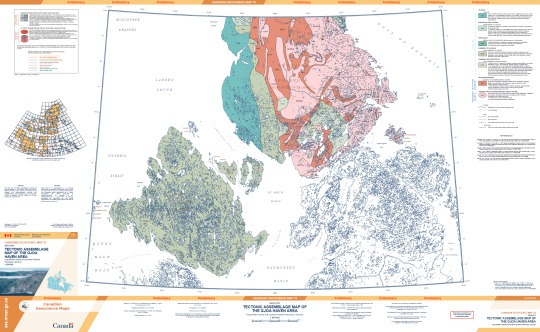
(This is an absolutely massive .pdf file with some scaled features so I would recommend viewing via the official publication to actually read anything or see fine details: publications.gc.ca/pub?id=9.557274&sl=0)
Notably, this map was published in 2015, 8 years after the novel was written. However, according to the bibliography for the map (which can be accessed via the previous link) a preliminary geologic map has existed for the area since at least 1967, though I was unable to track this publication down online. The novel was clearly thoroughly researched and Dan Simmons could have easily accessed this publication and others through multiple institutions.
The surficial geology of King William Island has also been mapped, and is predominantly glacial, as one would expect given it's location. For those unfamiliar with glacial geology processes, this is basically saying that the bedrock is buried under a bunch of glacial deposits. Glacial till is composed of rocks and sediments plucked from the bedrock and ground up. This is why the surface of the island is not one big rock, but a bunch of smaller pieces. Interestingly, the material on the southern part of the island is sandier because it contains more material derived from the Canadian Shield further south. If you're interested in glacial geology, I highly recommend zooming around a bit on Google Earth because the features here are GORGEOUS.
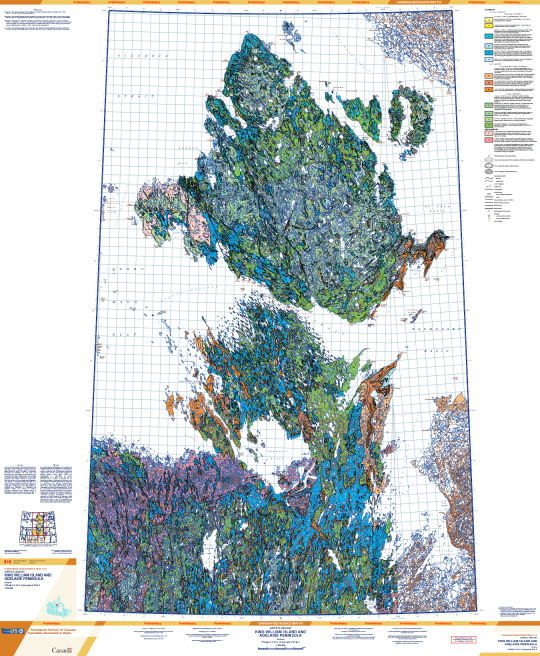
(This map is absolutely massive and the lines scale with zoom so it's hard to see at this resolution, access it here: publications.gc.ca/pub?id=9.834073&sl=0)
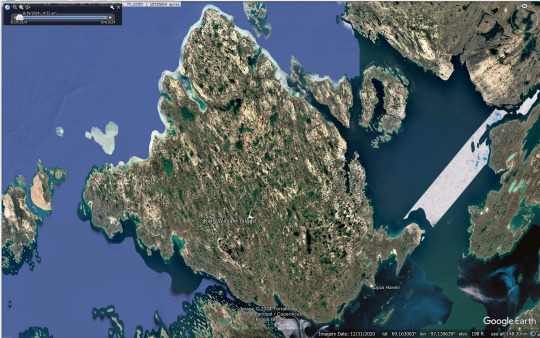
(Google Earth Pro, satellite imagery from 2020)
According to the surface geology map and Google Earth, the actual landscape of King William Island is much more water logged than it appears in the show. It's not entirely impossible that there has been some geomorphological change since 1848, but most of the features mapped would have been formed during the last ice age and as the glaciers melted and not more recently. This would have been handy for the men of the Franklin Expedition because each of these pools is filled with freshwater.
Pag, Croatia
Tracking down a geologic map of Croatia was somewhat challenging as I don't speak Croatian. I was able to find a map of the whole country, and while it's all in Croatian the symbol for the geologic time periods is universal so time periods can be correlated. This shows that the units that make up Pag are Cretaceous and Paleocene-Eocene in age.
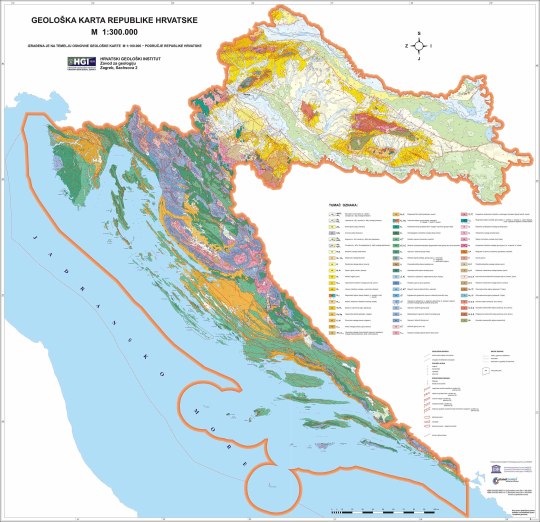
(Map accessed here: https://www.hgi-cgs.hr/en/geoloska-karta-republike-hrvatske-1300-000/)
I was able to find a .pdf (access here: http://kig.kartografija.hr/index.php/kig/article/view/158/274) that had a bit more information on the map above but at a lower resolution. This states that the Cretaceous units are dominantly carbonates from the Adriatic sea and the Eocene units are also carbonates. This makes sense as both the Cretaceous and Paleocene-Eocene boundary/PETM are times of increased global temperature correlated with increases in global sea level.
As always, the best geology website out there, Macrostrat, also came through on the unit lithologies. I was unable to access the source listed on Macrostrat, but both the Cretaceous (green) and Paleocene-Eocene units (orange) are listed as limestone.

(Source: https://macrostrat.org/map/#x=16&y=23&z=2)
One of the best views that we get of the geology on Pag is the last scene with Bridgens in episode 9. During the zoom out of this scene we get a really nice view of the bedrock and debris covering it.
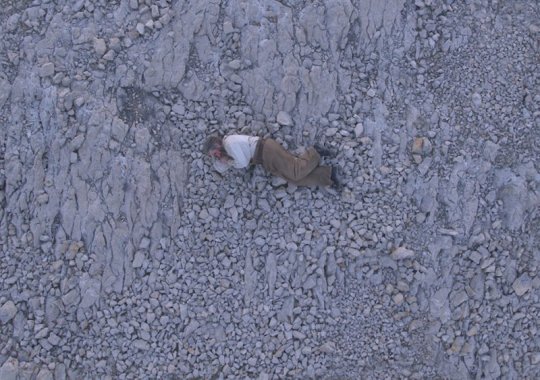
Given all of this, I'm really not sure where the landscape description as shale came from. If there is historical precedence for calling the rocks on the island shale, let me know! I have read a few books but none of the primary sources from the expeditions to this region, so if it comes from that I wouldn't be surprised.
Overall though, I have to say that the filming location was well chosen given the similarities it holds to the geology of King William Island.
#the terror#i have no idea whether this is of interest to anybody else#but i haven't been able to stop thinking about it since i started the show#because obviously the first thing i did was open up macrostrat to see what the geology was like#geology#peter posts#fr though the scene with bridgens is top tier in terms of getting a good view of the geology#it only took me three watches of the show to cave and make a post about it#franklin expedition
132 notes
·
View notes
Text
in HELLPIERCERS, we represent the larger War of Infernal Liberation through a strategy phase called STRATCOM. This phase takes a ton of inspiration from map games, like A Quiet Year, as well as faction-focused TTRPGs like REIGN.

Each faction gets its own map to start with, and you will spend a lot of the game adding buildings, locations, traps, hazards, armies, convoys, and more to it in the same kind of collaborative-combative vibe as the rest of the game, with the GM trying to dominate Hell, push back your forces, and retake lost locations, and the players pushing up toward the final fortress of the enemy faction.
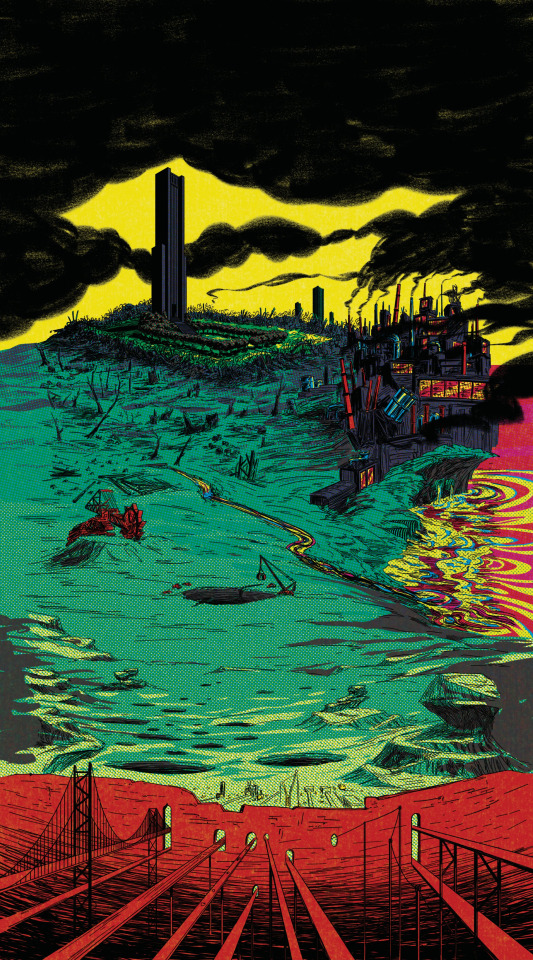
Each map is an abstraction, covering roughly a 800 mile stretch of territory that you'll grow into a complex visual log of The Last War.
First map is a representation of the SYNCRASIS faction's paleoproterozoic landscape, illustrated by the incredible @leafie-draws, and the second represents the industral-blasted nuclear wasteland of @leaftilde's AUTOPHYES faction, illustrated by the marquis of shadows, @jnbutlerart.

budget allowing I'd like to ship everyone two 11x17 trifolds with the maps printed, because Risk Legacy permanent changed my brain chemistry and i love the idea of physical maps covered in drawings and supply lines and armies and stuff.
How this side of the game plays out is very very much one of the more exciting elements of play, and I can't wait to see how you all engage with it. And remember, Hell is a prison. Break its bars.
168 notes
·
View notes
Text
Perspectives paleoart three, electric beegalee

"Filling the Hourglass" Francevillian Biota Paleoproterozoic, 2.1 billion years ago, Francevillian B formation (Gabon)
This is the Francevillian Biota! Might not be living, may or may not be eukaryotes, far too old to make sense of. If alive, they're notable for being some of the first multicellular organisms - a mysterious "precursor" branch that went extinct. Either that or they're just rock formations, but we can dream, right? They are being buried by silt from a delta.
This is part 2 of my Perspectives series! For more, check out #perspectives on my blog.
#perspectives#yee art#precambrian#evolution#paleontology#paleoart#ocean#nature art#paleoblr#palaeoblr#francevillian biota#francevillian
28 notes
·
View notes
Text

The Banded Iron Formation (BIF) near Gairloch, Scotland, is an ancient geological feature dating back to the Paleoproterozoic era, around 2.4 billion years ago. BIFs are distinctive sedimentary rocks consisting of alternating layers of iron-rich minerals and silica (typically in the form of chert), and they hold key clues to Earth’s early atmospheric and oceanic conditions. In Gairloch, the BIF is part of the Loch Maree Group, which is a sequence of metamorphosed volcanic and sedimentary rocks. This BIF formed during a time when the Earth’s oceans were rich in dissolved iron due to the lack of oxygen in the atmosphere. When oxygen started to be produced by photosynthetic microorganisms (such as cyanobacteria), it reacted with the iron in the oceans, precipitating out as iron oxide minerals. This process led to the formation of these alternating bands of iron and silica over millions of years. The Gairloch BIF is significant because it represents evidence of some of the earliest stages of oxygenation on Earth, known as the Great Oxidation Event (GOE). This event fundamentally changed the composition of the Earth’s atmosphere and oceans, allowing for the development of more complex life forms. The BIF also provides insights into the tectonic and volcanic activity during the early Proterozoic, as it is associated with volcanic rocks in the region. Due to its age and the tectonic activity that occurred in the area, the Gairloch BIF has undergone significant metamorphism. Despite this, the iron bands are still evident, and geologists study these formations to understand early ocean chemistry, the nature of ancient life, and the evolution of Earth’s atmosphere.
#Magnetic#Scotland#Luisa hendry#Hendry#Rocks#Geology#geologist#scottish geology#scottish geologist#reelsaboutrocks
14 notes
·
View notes
Text
The Weird Microorganism Iceberg
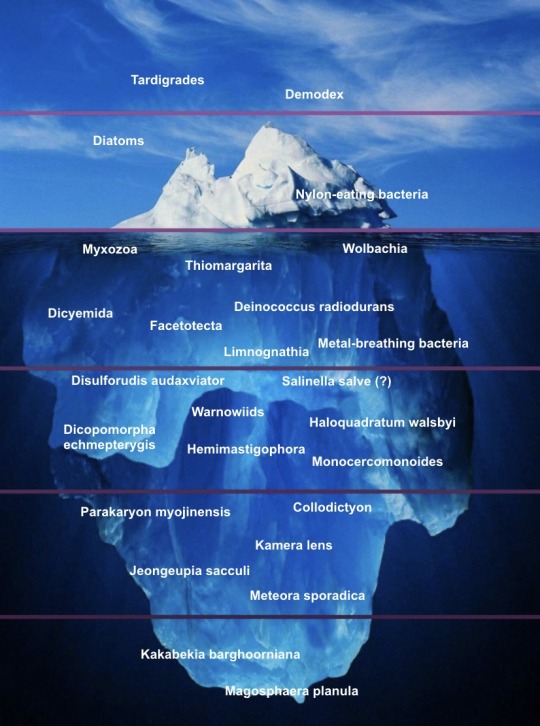
I basically made this on an impulse, please don’t take it too seriously. Feel free to suggest more organisms!
Explanations under the cut.
Tardigrades: You probably all know this one. Commonly said to be polyextremophiles, but this isn’t actually true; while they can survive extreme conditions, they don’t thrive in them. Something you might not know about them is that all of their body segment genes are equivalent to arthropod head genes — meaning they are basically walking heads.
Demodex: Eyelash mites.
Diatoms: Geometric silicon shell creatures.
Nylon-eating bacteria (Paenarthrobacter ureafaciens KI72): Exactly what it says on the tin.
Myxozoa: Single-celled parasitic cnidarians. Lack digestive systems, circulatory systems, gonads, and even muscles in some species. Also may or may not be autonomous cancer cells.
Thiomargarita: The only macroscopic bacteria. Honorary microorganisms for the purposes of this image.
Wolbachia: Parasitic / mutualistic bacteria genus that has created numerous insect species through their effects on reproduction. (Infected females can become capable of parthenogenesis, while infected males are either killed, turned into females, or limited to reproducing only with females infected by the same strain.)
Deinococcus radiodurans: A bacterium which unofficially holds the title of “most extreme extremophile”. Can survive incredibly high doses of radiation, as well as high acidity and very low temperatures.
Dicyemida: Symbiotic (once mistakenly thought to be parasitic) animals that live in cephalopod kidneys. Have alternation of generations and used to be known as “Rhombozoa” (“rhombus animals”).
Facetotectans: Parasitic crustaceans with an unknown adult form. Attempts to artificially induce metamorphosis only produce another juvenile stage, as far as anyone can tell.
Metal-breathing bacteria: Bacteria which use nanowires to accept electrons from metals.
Limnognathia: One of the smallest animals, and has 15-part extensible jaws.
Disulforudis audaxviator: The only known organism to comprise a single-species ecosystem. Lives over a mile underground and feeds off the byproducts of radioactive decay.
Salinella salve: Possibly nonexistent simple animal, allegedly cultured by Johannes Frenzel in 1892 but never found by anyone else.
Warnowiids (Warnowiaceae): A family of dinoflagellates which have modified some of their organelles into an eye… which somehow works well enough for them to aim their stingers at prey, despite them having no brain (or even other cells) to process the images.
Haloquadratum walsbyi: A square that lives in salt.
Dicopomorpha echmepterygis: The smallest known insect, a parasitoid wasp smaller than a Paramecium.
Hemimastigophora: A group of organisms recently discovered to be an early-splitting branch of the eukaryotes.
Monocercomonoides: A genus of “excavate” “protists” (both terms are polyphyletic, lol) that lack mitochondria… or even the genes for them.
Parakaryon myojinensis: The only complete incertae sedis, for which not even the domain is known. Has an odd mix of eukaryote and prokaryote-like features, leading to speculation that they represent a second incidence of endosymbiosis (aka Eukaryota 2.0). Also my blog’s namesake.
Collodictyon: Considered unclassifiable for a long time. Not really that weird in and of itself, tbh.
Kamera lens: Continuing the theme, this is an alga that has proven weirdly difficult to classify despite having been known for centuries (though it’s been narrowed down to the Ochrophyta). Its funny name makes it a pain to look up.
Jeongeupia sacculi: Recently-discovered multicellular(!) bacterium. Unlike everything else on here, it doesn’t have a Wikipedia page (yet).
Meteora sporadica: “Protist” which moves by rowing with a pair of arm-like appendages. Another difficult-to-classify organism, although a study from earlier this year suggests they are related to the Hemimastigophora.
Kakabekia barghoorniana: Apparent Paleoproterozoic living fossil that looks like an umbrella.
Magosphaera planula: A sphere which splits apart into amoeba-like cells, observed by Ernst Haeckel in 1869. Also possibly nonexistent / misidentified.
88 notes
·
View notes
Text
i don't get the "how many times do you think of the roman empire" trend because i've been hyperfixated on history since i was six. i think about it the same amount as i think about pre-colombian civilisations and the paleoproterozoic era. which is admittedly an insane amount, but it's my autism and i get to pick the music
#how many times do you think of the roman empire is also such a bullshit way of gendering subjects AGAIN#daniel is talking once again#history
19 notes
·
View notes
Text
People are at another level of idiocy. Bringing up "George only won twice, (insert name here) won 192728373773 times"
One is in his sixth season, 5 of which spend in a non race winning car. The other has been in the sport since the paleoproterozoic precambium siderian age
This is like asking a newbie nugu country swimmer/tennis player/figure skater at their first olympic
"Why haven't you got as many medals as Michael Phelps/Serena Williams/Evgeni Plushenko/Yuzuru Hanyu?"
4 notes
·
View notes
Text
Even the Oldest Eukaryote Fossils Show Dazzling Diversity and Complexity - Technology Org
New Post has been published on https://thedigitalinsider.com/even-the-oldest-eukaryote-fossils-show-dazzling-diversity-and-complexity-technology-org/
Even the Oldest Eukaryote Fossils Show Dazzling Diversity and Complexity - Technology Org
The sun has just set on a quiet mudflat in Australia’s Northern Territory; it’ll set again in another 19 hours. A young moon looms large over the desolate landscape. No animals scurry in the waning light. No leaves rustle in the breeze. No lichens encrust the exposed rock. The only hint of life is some scum in a few puddles and ponds. And among it lives a diverse microbial community of our ancient ancestors.
A soft summer evening in the Paleoproterozoic, as envisioned by DALL-E. Image credit: DALL-E, prompt by Harrison Tasoff.
In a new account of exquisitely preserved microfossils, researchers at UC Santa Barbara and McGill University revealed that eukaryotic organisms had already evolved into a diverse array of forms even 1.64 billion years ago.
The paper, published in the journal Papers in Paleontology, recounts an assemblage of eukaryotic fossils from an era early in the group’s evolutionary history. The authors describe four new taxa, as well as evidence of several advanced characteristics already present in these early eukaryotes.
“These are among the oldest eukaryotes that have ever been discovered,��� explained lead author Leigh Anne Riedman, an assistant researcher in UCSB’s Department of Earth Science. “Yet, even in these first records we’re seeing a lot of diversity.”
Eukarya forms one of the major domains of life, encompassing the plant, animal and fungi clades, as well as all other groups whose cells have a membrane-bound nucleus, like protists and seaweeds.
Many scientists had thought early eukaryotes were all fairly similar during the late Paleoproterozoic, and that diversification took place around 800 million years ago. But Riedman and her co-authors found fossils of a delightfully diverse, and complex, cast of characters in rock nearly twice as old.
Limbunyasphaera operculata is a new species that shows a small door opening into the cell. Photo Credit: Riedman et al.
Scientists knew from previous studies that eukaryotes had evolved by this time, but their diversity in this era was poorly understood. So Riedman headed to the Outback in late 2019. Within one week, she had collected about 430 samples from eight cores drilled by a prospecting company; they now reside in the library of the Northern Territory Geological Survey. The two cores used for this study spanned roughly 500 meters of stratigraphy, or 133 million years, with around 15 million years of significant deposition.
Riedman returned to the United States with shale and mudstone: remnants of an ancient coastal ecosystem that alternated between shallow, subtidal mudflats and coastal lagoons. A dip in hydrofluoric acid dissolved the matrix rock, concentrating the precious microfossils which she then analyzed under the microscope.
“We were hoping to find species with interesting and different characteristics to their cell walls,” Riedman said. She hoped that these features could shed light on what was happening within the cells during this time period. Reaching any conclusions about the cellular interior would require a great deal of sleuthing, though, since the fossils preserve only the exterior of the cells.
The researchers were surprised by the diversity and complexity preserved in these fossils. They recorded 26 taxa, including 10 previously undescribed species. The team found indirect evidence of cytoskeletons, as well as platy structures that suggest the presence of internal vesicles in which the plates were formed — perhaps ancestral to Golgi bodies, present in modern eukaryotic cells. Other microbes had cell walls made of bound fibers, similarly suggestive of the presence of a complex cytoskeleton.
The authors also found cells with a tiny trapdoor, evidence of a degree of sophistication. Some microbes can form a cyst to wait out unfavorable environmental conditions. In order to emerge, they need to be able to etch an opening in their protective shell.
Making this door is a specialized process. “If you’re going to produce an enzyme that dissolves your cell wall, you need to be really careful about how you use that enzyme,” Riedman said. “So in one of the earliest records of eukaryotes, we’re seeing some pretty impressive levels of complexity.”
Many people in the field had thought this ability emerged later, and the evidence for it in this assemblage further emphasizes how diverse and advanced eukaryotes were even at this early juncture.
“The assumption has always been that this is around the time that eukaryotes appeared. And now we think that people just haven’t explored older rocks,” said co-author Susannah Porter, an Earth science professor at UC Santa Barbara.
This paper is part of a larger project investigating early eukaryote evolution. Riedman and Porter want to know in what environments early eukaryotes were diversifying, why they were there, when they migrated to other places, and what adaptations they needed in order to fill those new niches.
A big part of this effort involves understanding when different characteristics of eukaryotes first arose. For instance, the authors are quite interested to learn whether these organisms were adapted to oxygenated or anoxic environments.
The former would suggest that they had an aerobic metabolism, and possibly mitochondria. Every modern eukaryote that’s been found descends from ancestors that possessed mitochondria. This suggests that eukaryotes acquired the organelle very early on, and that it provided a significant advantage.
Riedman and Porter are currently working on a fresh account of eukaryote diversity through time. They’ve also collected even older samples from Western Australia and Minnesota. Meanwhile, their geochemist collaborators at McGill are spearheading a study on oxygen levels and preferred eukaryote habitats, aspects that could shed light on their evolution.
“These results are a directive to go look for older material, older eukaryotes, because this is clearly not the beginning of eukaryotes on Earth,” Riedman said.
Source: UCSB
#Animals#Australia#billion#Biotechnology news#cell#Cells#Chemistry & materials science news#Community#complexity#dall-e#deal#diversity#domains#earth#Environmental#enzyme#eukaryotic cells#Evolution#Explained#Features#fibers#form#Forms#Fossils#fungi#Genetic engineering news#History#how#it#Landscape
2 notes
·
View notes
Text
I had to break out my final paper for this because this is my favorite part of Biology.
It's is called the Mitochondrial Theory. The DNA of a Mitochondria is purely maternal and, therefore can only be traced back through your mother's side. It is self-replicating, independent of the other organelle replication during the S stage (Synthesize) of the cell life right before division (mitosis/meiosis). It copies itself continuously to keep the cell's power and water levels balanced (isotonic). Plants have a secondary version of mitochondria called a chloroplast.
I'm calling it a secondary version because how it became a part of our cells to evolve into us one day is the same as mitochondria. The only difference is that chloroplasts uniquely perform photosynthesis (and its GREEN) Plants have both chloroplasts and mitochondria because of their simple energy sources (water, sunlight, fertile soil).
Hazard Symbols were right when they said they were their own domain, but to me, that only scratches the surface of our cells and their evolution from pre-Cambrian history (creation of our solar system).
I'll use these paragraphs from my paper to explain:
After balancing earth's atmosphere and perfecting the ATP production of proto-bacteria, one day an archaea cell, most similar to Aagard Achaea, 'consumed' its bacterial cousin, alphaproteobacteria, and enslaved it for future generation for its efficient ATP production. The first merger of the two Domains was with a with aerobic mitochondria, creating animal simple cells as we know them today, while the second merger added chloroplasts, creating the green plants. From this, came the next expansion of life as the Eukarya domain was made and the first primitive Eukaryotic cells started to populate earth. These basic cells populated the thermally heated ground around underwater vents slowly from the glaciation and the Great Oxidation event during the Neoarchean (last Archaen Era) - Paleoproterozoic (First Era of the Proterozoic Eon) boundary.

This first multi-cellular life that originated on this earth is the still debated 'Francevillian biota', a collection of 2.1-billion-year-old Palaeoproterozoic macroscopic structures. After this new life was also the expansion into the creation of fungi. Fungi diverged from other life around 1.5 billion years ago, with the glomaleans branching from the "higher fungi" at ~570 million years ago. This took up the Mesoproterozoic - Neoproterozoic era conjunction and most of the ending periods the Proterozoic Eon. These ending periods both were the catalyst and backbone for the Cryogenian period (1), which in turn set off the Cambrian Expansion (2).

(1) The Cryogenian is a geologic period that lasted from 720 to 635 million years ago. It is the second of the three periods of the Neoproterozoic era, preceded by the Tonian and followed by the Ediacaran. The Cryogenian was a time of drastic climate changes. After the long environmental stability/stagnation, this glaciation froze the entire planet in a state of severe icehouse climate known as a snowball Earth. After 70 million years it ended, but was quickly followed by another global ice age, the Marinoan glaciation. There is controversy over whether these glaciations indeed covered the entire planet, or whether a band of open sea survived near the equator (i.e. "slushball Earth"), but the extreme climates with massive expanse of ice sheets blocking off sunlight would nevertheless have significantly hindered primary production in the shallow seas and caused major mass extinctions and biosphere turnovers.
(2) The Cambrian explosion is an interval of time beginning approximately 538.8 million years ago in the Cambrian period of the early Paleozoic, when a sudden radiation of complex life occurred and practically all major animal phyla started appearing in the fossil record. It lasted for about 13 to 25 million years and resulted in the divergence of most modern metazoan phyla. B
If you want more information, check out my paper:
Chaos and Order - Copy.docx

17K notes
·
View notes
Text
CRINGE FAILURE!!!! EUCARYOTE cells LACK periplasmic space‼️
How do they form proton gradients⁉️⁉️ We may never know...🤔🤔🤔🤔
They don't even have peptidoglycan🤣🤣🤣🤣 IDIOTIC STUPID eucaryotes! Who knows how they made it past the Paleoproterozoic.
#Look at this idiot! 👉 (o`.)-~#No Horizontal Gene Transfer?🤨🤨🦠🦠🦠🦠🦠#biology#prokaryoteposting#prokaryotes#shitpost
1 note
·
View note
Text
Plants are Fucking Weird
This is a thought that has only just started to plague me, but I needed to infect others with it.
SO! We all know that plants and other photosynthesizers process oxygen, right? The thing that keeps our respirating asses alive? We've all seen the oversimplified diagrams.

And they can do that shit with only .04% of the atmosphere being CO2!
BUT! But. Plants still do cell respiration!

Meaning that they still need oxygen! Clearly less than what they produce as evidenced by the vast majority of the animal kingdom being oxygen sinks and the atmosphere still sitting comfortably at 21% oxygen.
I just think it's fucking wild that entire swatches of Earth's biosphere are dependent on the fact that plants are massive overproducers of a highly reactive and explosive gas that they need themselves to survive.
And don't even get me started on the Great Oxygen Catastrophe of the Paleoproterozoic.
#random#science#life on earth is weird#imagine if plants were anaerobic#how much oxygen would earth end up with?
0 notes
Text
Earth's magnetic field nearly collapsed some 590 million years ago, presumably putting life on the planet's surface at risk of a rise in cosmic radiation.
According to new research, the temporary weakening of the magnetic shielding might have been anything but a biological catastrophe. In fact, it may have boosted oxygen levels, creating prime conditions for early life to blossom.
"Earth's magnetic field was in a highly unusual state when macroscopic animals of the Ediacara fauna diversified and thrived," University of Rochester Earth scientist Wentao Huang and colleagues write in their new paper.
In 2019, scientists studying magnetic signatures in rocks from Canada reported that those samples indicated Earth's magnetic field weakened to its lowest known level about 565 million years old, during the Ediacaran period, when multicellular life was taking shape.
However, it was long thought that a vanishingly small magnetic field would be harmful to emerging life, because Earth's magnetic field shields life from solar winds.
Not everyone agreed with that catastrophic view, though. As far back as 1965, planetary scientist Carl Sagan argued that Earth's atmosphere and oceans could have served as a protective blanket for early lifeforms even if the planet's magnetic field waned. This was backed up by modeling studies as recent as 2019.
But any connection between a coinciding weakness in magnetic field, boom in Ediacaran life, and rise in oxygen levels has remained – as Huang and colleagues put it – "tantalizing but unclear." The Canadian results could be an outlier.
So Huang and colleagues went digging. They dug up igneous rocks from South Africa that formed billions of years ago and studied crystals in them and other 591 million-year-old rocks previously sampled from Brazil. These crystals contain tiny magnetic minerals, which preserve the intensity of the Earth's magnetic field as they form.
Just over 2 billion years ago, smack-bang in the middle of the Paleoproterozoic period, Earth's magnetic field was strong. Roughly 1.5 billion years later it dropped to its lowest ebb – about 30 times weaker than it is today, the researchers found.
Combining their results with those of the 2019 Canadian study, Huang and colleagues conclude that this lowly magnetic field (named the ultra-low time-averaged field intensity, or UL-TAFI) lasted for at least 26 million years, from 591 to 565 million years ago.
Coincidentally, this interval overlaps with a surge in atmospheric and oceanic oxygen levels around 575–565 million years ago, during the late Ediacaran, when there was also an explosion in biodiversity.
"The new data confirming and extending the UL-TAFI strengthen a potential linkage with the Ediacaran evolution of macroscopic animals," Huang and colleagues write.
But there was still the question of how an ultra-weak magnetic field could lead to increased oxygen levels. Modeling solar wind evolution, Huang and colleagues suggest the weakened magnetic field may have allowed more hydrogen ions to escape from Earth's atmosphere into space, which could have resulted in higher oxygen levels in the seas and skies, in turn supporting the diversification of Ediacaran life.
The timing at the end of Ediacaran, some 540 million years ago, is surprising – typically it's the Cambrian explosion that is regarded for its evolutionary outburst, giving rise to complex life that became the animals and insects we see today.
The Ediacaran, by contrast, is known for its slimy, squishy creatures that look like primordial sponges, slugs and sea anemones. It was a period of great evolutionary experimentation that resulted in many dead ends, and was marked by steep declines in biodiversity before life rebounded in the Cambrian.
Recent research suggests, however, that the first complex ecosystems might have actually formed in the Ediacaran, with a 2022 study describing increasingly complex community structures in fossils from the late Ediacaran.
But life needs oxygen to grow bigger and more complex. Microscopic marine animals and sponges can survive in low-oxygen oceans, but larger, mobile animals with complex body plans need more oxygen to support their metabolic demands.
"A complex animal ecosystem involving long food chains and predators requires still greater amounts of oxygen, as indicated by the exclusion of such complex ecosystems from the modern oxygen minimum zone," Huang and colleagues explain.
It seems Ediacaran life seized its moment when Earth's magnetic field faded, even if many of those creatures were destined to run into an evolutionary dead end.
The study has been published in Communications Earth & Environment.
0 notes